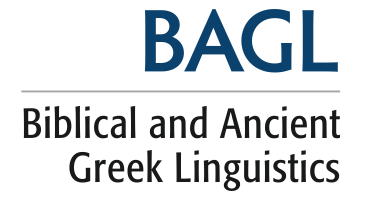11.1 | Yan Ma Canadian Chinese School of Theology, Toronto, Canada Rhetorical Structure Theory (RST), which was originally developed by William
C. Mann and Sandra A. Thompson as a functional theory to describe the text structure
of written discourse, has been further advanced and incorporated into Systemic
Functional Linguistics (SFL) by Christian M. I. M. Matthiessen. This study aims to
introduce this new method to New Testament discourse analysis by integrating the
features of New Testament Greek. This study also demonstrates the application of RST
by conducting a rhetoricalrelational analysis on John 8:31–59 to verify that RST can
serve as an effective tool for New Testament interpretation and will offer new
insights relevant to New Testament studies. Keywords: Systemic Functional Linguistics, Rhetorical Structure Theory, discourse
analysis, New Testament interpretation, Gospel of John |
11.2 | Hojoon J. Ahn Sungkyul University, Anyang-si, South Korea Among 421 variants in the Gospel of Luke revealed from a
comparative analysis between TD8 and NA28, this study attempts a
textual-critical analysis of five tense-form variants (Luke 7:20, 24,
25, 26; 22:52) in terms of verbal aspect theory. First, concerning their
age, geographical features, and genealogical features, the aorist
readings (ἀπέστειλεν, ἐξήλθατε) can probably be regarded as superior
to the perfect readings (ἀπέσταλκεν, ἐξεληλύθατε). Second,
considering the internal evidence revealed via verbal aspect theory,
the aorist readings have more weight than the perfect readings.
Regarding the reason why Tischendorf chose the perfect tense-form
reading even though important MSS (e.g., P75 א B) support the aorist
reading, this study suggests that, via Georg B. Winer who was his
teacher, Tischendorf had a tense-centered Greek understanding. In
addition, concentrating on the perfect tense-form reading of the 4–5c
MSS such as A (02) and W (032), this study suggests that the
variations involved here may have helped to initiate the change from
the reading based on the verbal aspect to a tense-centered reading in
the 4c. This study reveals the need for, and significance of, verbal
aspect theory for NT textual criticism. Keywords: Textual criticism, verbal aspect, Gospel of Luke, Constantine Tischendorf |
11.3 | Stanley E. Porter McMaster Divinity College, Hamilton, Canada This paper argues that a natural language approach to the
Greek of the New Testament is needed in order to perform the kind of
exegesis that recognizes crucial characteristics of Greek as a language
and that takes into account important developments in linguistic
thought about language. The paper questions many of the ways that
exegesis is done in contemporary New Testament studies by failure
to use a natural language approach. Two major examples of
exegetical approaches are used to exemplify some of the problems
that arise when the Greek language of the New Testament is not seen
to be a variety of Koine Greek of the Hellenistic or Greco-Roman
period. Keywords: Natural language, Greek, exegesis, Koine, linguistics |
11.4 | Martin M. Culy Cypress Hills Ministries While all scholars agree that responsible interpretation of
the Greek New Testament requires the use of a variety of exegetical
tools, it is exceedingly rare to find treatments of hermeneutics or
exegesis that address the importance of being able to actually read,
rather than simply decode, the biblical text in its original languages.
This study considers the ramifications of this gap in exegetical
training and practice primarily through illustrating how a lack of fluid
reading skills may lead modern exegetes to misread the biblical text
in a variety of ways. Keywords: Koine Greek, exegesis, reading skills |
11.5 | James D. Dvorak McMaster Divinity College, Hamilton, Canada Context has often been understood primarily in a literary
sense, referring to the text appearing immediately before and
immediately following the unit under investigation. Some use the
term to refer to the historical setting or situatedness of a text,
including such features as the significant people, places, things, and
events leading up to and/or existing during the time in which the
author lived and wrote. Yet neither of these notions of context is
sufficient, and even taken together they do not offer a complete
picture. The present article proposes a more complex (yet still
workable) and delicate model of context that is rooted in
sociolinguistic and cultural anthropological theory. Keywords: context, context of culture, context of situation,
sociolinguistics, Systemic Functional Linguistics, cultural
anthropology, social-scientific criticism |

